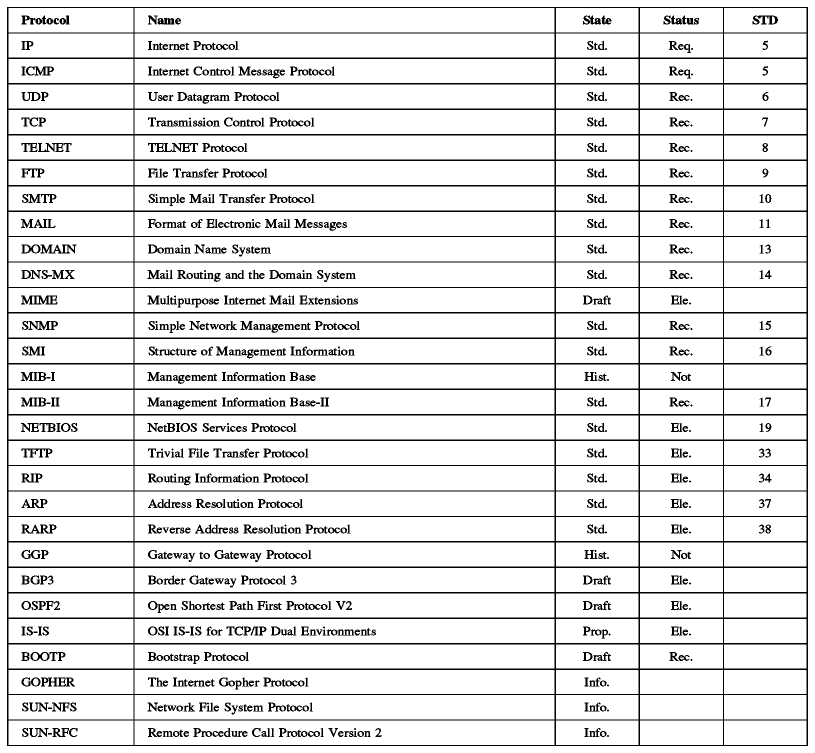 Table of Contents
Table of Contents  Future
- High-Speed Networking
Future
- High-Speed Networking Table of Contents
Table of Contents  Future
- High-Speed Networking
Future
- High-Speed Networking
The Internet protocol suite is still evolving through the mechanism of Request For Comments (RFC). New protocols (mostly application protocols) are being designed and implemented by researchers, and are brought to the attention of the Internet community in the form of an RFC. (0)The RFC mechanism is overseen by the Internet Architecture Board (IAB). The largest source of RFCs is the Internet Engineering Task Force (IETF) which is a subsidiary of the IAB. However, anyone may submit a memo proposed as an RFC to the RFC Editor. There are a set of rules which RFC authors must follow in order for an RFC to be accepted. These rules are themselves described in an RFC (RFC 1543) which also indicates how to submit a proposal for an RFC.
Once an RFC has been published, all revisions and replacements are published as new RFCs. A new RFC which revises or replaces an existing RFC is said to ``update'' or to ``obsolete'' that RFC. The existing RFC is said to be ``updated by'' or ``obsoleted by'' the new one. For example RFC 1521 which describes the MIME protocol is a ``second edition'', being a revision of RFC 1341 and RFC 1590 is an amendment to RFC 1521. RFC 1521 is therefore labelled like this: ``Obsoletes RFC 1341; Updated by RFC 1590''. Consequently, there is never any confusion over whether two people are referring to different versions of an RFC, since there are never different versions.
Some RFCs are described as information documents while others describe Internet protocols. The Internet Architecture Board (IAB) maintains a list of the RFCs that describe the protocol suite. Each of these is assigned a state and a status.
An Internet protocol can have one of the following states:
Definitions of protocol status:
Proposed standard, draft standard and standard protocols are described as being on the Internet Standards Track. The standards track is controlled by the Internet Engineering Steering Group (IESG) of the IETF. When a protocol reaches the standard state it is assigned a standard number (STD). The purpose of STD numbers is to clearly indicate which RFCs describe Internet standards. STD numbers reference multiple RFCs when the specification of a standard is spread across multiple documents. Unlike RFCs, where the number refers to a specific document, STD numbers do not change when a standard is updated. STD numbers do not, however, have version numbers since all updates are made via RFCs and the RFC numbers are unique. Thus to unambiguously specify which version of a standard one is referring to, the standard number and all of the RFCs which it includes should be stated. For instance, the Domain Name System (DNS) is STD 13 and is described in RFCs 1034 and 1035. To reference the standard, a form like ``STD-13/RFC-1034/RFC-1035'' should be used. For a description of the Standards Process, see RFC 1602 -- The Internet Standards Process - Revision 2.
For some standards track RFCs the status category does not always contain enough information to be useful. It is therefore supplemented, notably for routing protocols by an applicability statement which is given either in STD 1 or in a separate RFC.
References to the RFCs and to STD numbers will be made throughout this book, since they form the basis of all TCP/IP protocol implementations.
Four Internet standards are of particular importance:
A number of RFCs which are intended to be of wide interest to Internet users are classified as For Your Information (FYI) documents. They frequently contain introductory or other helpful information. Like STD numbers, an FYI number is not changed when a revised RFC is issued. Unlike STDs, FYIs correspond to a single RFC document. For example, FYI 4 -- FYI on Questions and Answers - Answers to Commonly asked ``New Internet User'' Questions is currently in its fourth edition. The RFC numbers are 1177, 1206, 1325 and 1594.
All RFCs are available publicly, both in printed and electronic form from the Internet Network Information Center or InterNIC (internic.net). Prior to 1993, the NIC function was performed by the DDN NIC (nic.ddn.mil). See RFC 1400 for more information about the transition.
To: rfc-info@ISI.EDU Subject: getting rfcs help: ways_to_get_rfcs
EXEC TOOLS SENDTO ALMVMA ARCNET RFC GET RFCnnnn TXT *Where nnnn refers to the number of the RFC.
To obtain the list of all the RFCs (and to know if they are available in TXT format or in PostScript format), use the command:
EXEC TOOLS SENDTO ALMVMA ARCNET RFC GET RFCINDEX TXT *
To give an idea of the importance of the major
protocols, we list some of them together with their current state and status
and STD number where applicable in Table - The
Current state and status and STD numbers of Important Internet protocols.
The complete list can be found in RFC 1780 - Internet Official Protocol
Standards. Legend:
State: Std. = Standard; Draft = Draft Standard; Prop. = Proposed
Standard; Info. = Informational; Hist. = Historic
Status: Req. = Required; Rec. = Recommended; Ele. = Elective; Not = Not
Recommended

Table: The Current state and status and STD numbers of Important Internet
protocols
At the time of writing there is no RFC associated with the HyperText Transfer Protocol used in World Wide Web implementations. However, the document HyperText Transfer Protocol (HTTP) written by Tim Berners-Lee may be obtained at ftp://info.cern.ch/pub/www/doc/http-spec.text.
In addition, the following RFCs describe the Uniform Resource Locator (URL) and associated concepts: